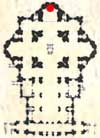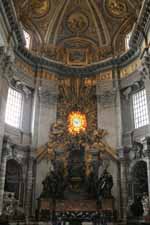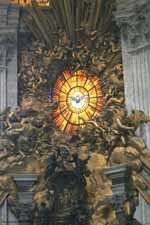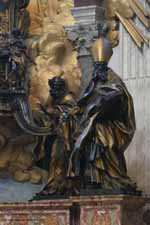| Grottoes
Vatican City Colonnade Saints Floorplan #2 |
| Altars
Monuments The History |
| Related
Items The Tribune |
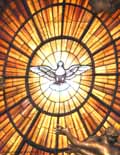
|
 |
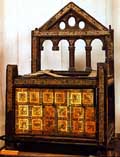 |
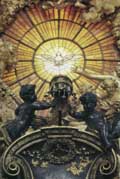 |
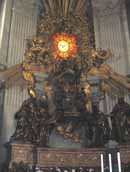 |
 |
From: 'St. Peter's - Guide to the Basilica and Square '
The apse is at the end of the central nave. In the center is the Altar
of the Chair of Peter, a masterpiece which is unmistakably the work of
Gian Lorenzo Bernini (1598-1659).
Every year on February 22, the Church celebrates the feast of the Chair of St. Peter, to commemorate St. Peter's teaching in Rome. Already in the second half of the 18th century an ancient wooden chair inlaid with ivory was venerated and traditionally held to be the Episcopal chair on which St. Peter sat as he instructed the faithful of Rome. In fact, it is a throne in which fragments of acacia wood are visible, which could be part of the chair of St. Peter, encased in oak and reinforced with iron bands. Several rings facilitated its transportation during processions. Pope Alexander VII commissioned Bernini to build a sumptuous monument which would give prominence to this ancient wooden chair. Bernini built a throne in gilded bronze, richly ornamented with bas-reliefs in which the chair was enclosed: two pieces of furniture, one within the other. On January 17, 1666 it was solemnly set above the altar.
The base of the altar is made of black and white marble from Aquitaine and red jasper from Sicily. Four gigantic statues (about 5 m. tall) in gilded bronze surround the Chair which looks almost as if it were suspended amidst the clouds. The two outer statues are figures of two Doctors of the Latin Church: St. Ambrose and St. Augustine; the two inner statues, with bare heads, are of two Doctors of the Greek Church: St. Athanasius and St. John Chrysostom. These saints represent the catholicity of the Church and at the same time, the consistency of the theologians' teaching with the doctrine of the Apostles.
Above the Chair are two angels bearing the tiara and keys, symbols of the Roman pontiff's authority. On the Chair, are three bas-reliefs picked out in gold, which refer to the same number of Gospel episodes: the Consignment of the keys, Feed my sheep, and the Washing of the feet.
The whole composition is crowned by the fantastic gilt and stucco Gloria peopled by a host of angels among rays of light and gigantic billowing clouds. In their midst is the precious window of Bohemian glass, divided into twelve sections as a tribute to the Twelve Apostles; a brilliant dove stands out against it, the symbol of the Holy Spirit, the soul of the Church which he never ceases to help and to guide. Vanvitelli decorated the vault with gilded stucco. In the three medallions are portrayed: the Consignment of the Keys, the Crucifixion of St. Peter and the Beheading of St. Paul.
From:
'Guide to Saint Peter's Basilica'
This structure is a brilliant creation by Bernini, designed to display
the chair on which, according to ancient tradition, St. Peter sat and
taught Roman Christians. Pope Alexander VII had the ivory-covered chair
put into the gigantic bronze cathedra, with the statues of the Doctors
of the Church, St. Ambrose and St. Augustine of the Roman Church and St.
Athanasius and St. John Chrysostom of the Greek Church. The religious
significance is extremely clear. The Doctors of the Church were always
consistent with Peter's teachings as they expounded theological doctrine.
The gospel does not change because the Holy Spirit, portrayed as a dove flies along the span of the centuries, assisting and accompanying its church. The chair or cathedra of Peter symbolizes the perpetual continuity of the doctrine and its promise of infallibility. It triumphed over all heresies throughout the centuries.
The fine alabaster
window, surrounded by golden clouds and angels flying between rays of
light, casts a mystical warmth through the basilica, especially in the
afternoon. It is divided into twelve sections, in homage to the twelve
Apostles who carried the words of the Gospel throughout the world.
From:
'St. Peter's Basilica - A Virtual Tour' by Our
Sunday Visitor
St. Peter's Chair is perfectly visible through Bernini's Canopy even from
the entrance. It is a large bronze structure containing the ancient oak
Throne decorated with small carved ivory plaques showing the labors of
Hercules and some celestial constellations.
An ancient tradition holds that the Apostle himself sat upon it during sermons. However, the archaeologist G.B. De Rossi, who was able to examine the venerable relic during one of the centenary festivities in 1867, the last time that the Chair was put on show, concluded that only the acacia wood skeleton dates from the early age, while the other parts in oak, anchored to the skeleton by strips of iron and the ivory plaques, belong to a re-construction of the Chair made in the Byzantine period.
The antique relic was held in the monastery of St. Martin, situated where the Veronica pier presently stands. After being moved to various positions, in 1656 Alexander VII decided to place the Chair in a position worthy of its importance, entrusting Bernini with the task. He devised another ingenious solution, in line with that of his Canopy, to position the new work harmoniously in one of the most prominent parts of the Basilica, without altering the previous style impressed upon it by Bramante and Michelangelo.
His son Domenico was thus able to write in his biography of his father "he created the beginning and the end of that great Basilica." Once again, he devised a mobile kind of architecture, which was not superimposed upon the fabric of the building, but was a joyous decoration, of a kind similar to the temporary theater machinery more than once designed by him. In fact, he encased the ancient Chair in gilded bronze, surrounding it with four statues, again in bronze, of the Doctors of the Church, which seem almost as if they are about to lift it and bear it in procession.
Pope Benedict
XVI's address on the feast of the Chair of St. Peter
Date: 2006-02-22 VATICAN CITY
"A Privileged Sign of the Love of God" (Zenit.org).
Here is a translation of Benedict XVI's address at today's general audience, on the feast of the Chair of St. Peter.
Dear Brothers and Sisters! The Latin liturgy celebrates today the feast of the Chair of Peter. It is a very ancient tradition, witnessed in Rome since the end of the fourth century, which renders thanksgiving to God for the mission entrusted to the Apostle Peter and his successors.
"Cathedra" literally means the established seat of the bishop, located in the mother church of a diocese, which for this reason is called "cathedral," and it is the symbol of the authority of the bishop and, in particular, of his "magisterium," that is, of the evangelical teaching that he, insofar as a successor of the apostles, is called to guard and transmit to the Christian community.
When the bishop takes possession of the local Church that is entrusted to him, he, bearing the miter and the shepherd's crosier, sits on the cathedra. From that seat he will guide, as teacher and shepherd, the journey of the faithful in faith, hope and charity.
Which was, then, the "cathedra" if St. Peter? He, chosen by Christ as "rock" on which to build the Church (cf. Matthew 16:18), began his ministry in Jerusalem, after the ascension of the Lord and Pentecost. The first "seat" of the Church was the Cenacle, and in all probability in that room, where Mary, the Mother of Jesus, also prayed with the disciples, a special place was reserved for Simon Peter.
Subsequently, the see of Peter was Antioch, a city situated on the Oronte River in Syria, today Turkey, which at the time was the third metropolis of the Roman Empire after Rome and Alexandria in Egypt. Of that city, evangelized by Barnabas and Paul, where "for the first time the disciples were called Christians" (Acts 11:26), Peter was the first Bishop.
In fact, the Roman Martyrology, before the reform of the calendar, established also a specific celebration of the Chair of Peter at Antioch. From there, Providence led Peter to Rome, where he concluded with martyrdom his course of service to the Gospel. For this reason, the See of Rome, which had received the greatest honor, received also the task entrusted by Christ to Peter of being at the service of all the local Churches for the building and unity of the whole People of God.
In this way the See of Rome came to be known as that of the Successor of Peter, and the "cathedra" of its Bishop represented that of the apostle charged by Christ to feed all his flock. It is attested by the most ancient Fathers of the Church, as for example St. Irenaeus, bishop of Lyon, who in his treatise "Against Heresies" describes the Church of Rome as "greatest and most ancient, known by all; … founded and constituted at Rome by the two glorious Apostles Peter and Paul"; and he adds: "With this Church, because of her outstanding superiority, the universal Church must be in agreement, that is, the faithful everywhere" (III, 3, 2-3).
Tertullian, for his part, affirms: "How blessed this Church of Rome is! The Apostles themselves shed on her, with their blood, the whole of the doctrine" ("La Prescrizione degli Eretici," 36). The Chair of the Bishop of Rome represents, therefore, not only his service to the Roman community, but also his mission of guide of the whole People of God.
To celebrate the "Chair" of Peter, as we do today, means, therefore, to attribute to it a strong spiritual significance and to recognize in it a privileged sign of the love of God, good and eternal Shepherd, who wants to gather the whole of his Church and guide her along the way of salvation.
Among so many testimonies of the Fathers, I would like to refer to that of St. Jerome, taken from a letter of his to the Bishop of Rome, particularly interesting because he makes explicit reference in fact to the "chair" of Peter, presenting it as the safe harbor of truth and peace. Jerome writes thus: "I decided to consult the chair of Peter, where that faith is found exalted by the lips of an Apostle; I now come to ask for nourishment for my soul there, where once you received the garment of Christ. I follow no leader save Christ, so I enter into communion with your beatitude, that is, with the chair of Peter for this I know is the rock upon which the Church is built! ("Le Lettere," I, 15,1-2).
Dear Brothers and Sisters, in the apse of St. Peter's Basilica, as you know, is found the monument to the Chair of the Apostle, a mature work of Bernini, made in the shape of a great bronze throne, supported by the statues of four Doctors of the Church, two from the West, St. Augustine and St. Ambrose, and two from the East, St. John Chrysostom and St. Athanasius.
I invite you to pause before that evocative work, which today it is possible to admire decorated with so many candles, and pray in a particular way for the ministry that God has entrusted to me. Raising one's gaze to the alabaster glass window that opens precisely above the chair, invoke the Holy Spirit, so that he will always sustain with his light and strength my daily service to the whole Church. For this, as for your devoted attention, I thank you from my heart.
